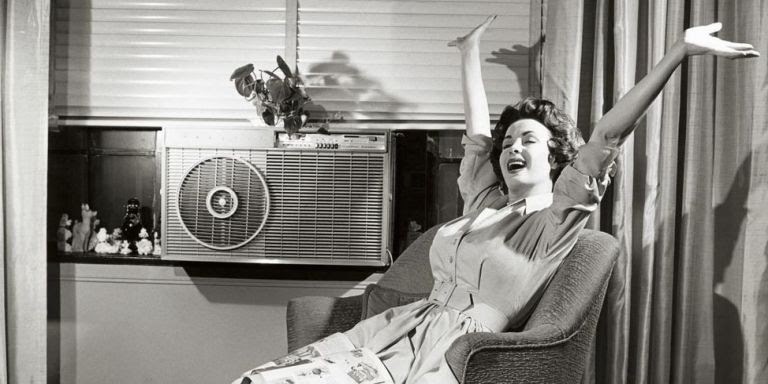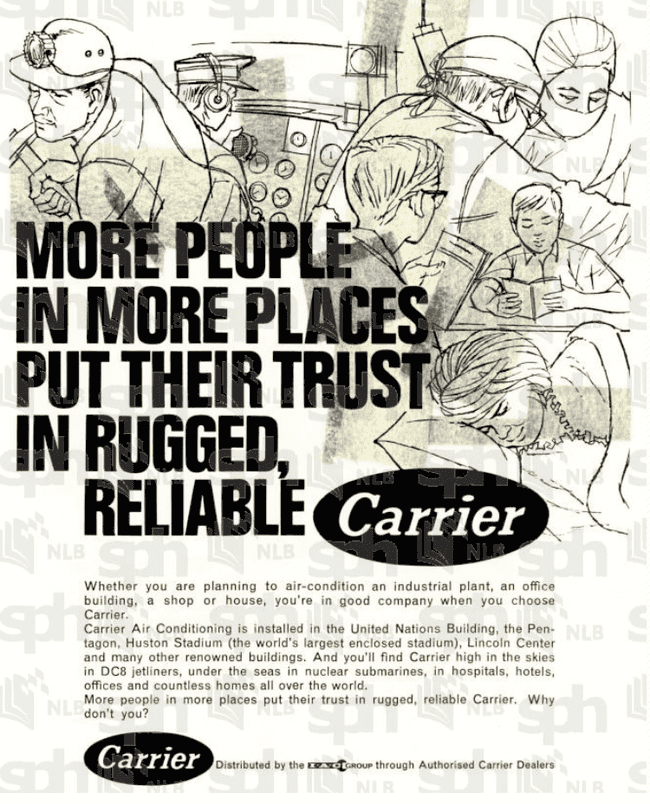
Introduction of Air Conditioning into Singapore
By Fiona Williamson

A Carrier advertisement in the Straits Times Annual portraying Carrier Air Conditioning as trusted and reliable even in the most rugged conditions. Source: Straits Times Annual, 1 January 1969, Page 136/137.
Singapore adopted air-conditioning in the 1930s. The first supplier was the ‘Carrier Air Conditioning Company of America’ who had moved into supplying Asian markets in 1930. The company even sent a marketing representative to Singapore in the late-30s, who proceeded to travel the length of the Malayan peninsula promoting unit sales.
Not to be outdone, their rival ‘American Trane Air Conditioning’ also arrived on the scene, determined to grab some of the newly emerging Asian market. The costs however – around $600 per plant – meant that only the very rich could afford domestic units, so they were mainly bought up by commercial enterprises and hospitals until the 1950s.
The first unit installed was at the Chinese Recreation Club in 1932, and by 1936, air-conditioning was standard in all newly purchased first-class rail carriages imported from the UK. Mail trains also started getting dedicated air-conditioned carriages from 1937 and it was used on normal trains running cross-country from Singapore through Kuala Lumpur to Penang by 1938.
Back in town, Singapore General Hospital installed air conditioning in their main operating theatre in 1938 and interestingly, Singapore Dairy Farm brought in air conditioning for their cattle sheds the same year. There was also talk of introducing air conditioning to stables catering for thoroughbred racehorses.
It was the world of entertainment, however, that saw the most investment in the new technology. The Alhambra cinema on Beach Road is renowned as the first cinema to have been air conditioned, in 1938; an initiative brought in by the Shaw Brothers, the wealthy Shanghainese family who dominated the early Asian film production industry.
Seeing an air-conditioned venue as a marketing strategy, they expanded the technology to their other entertainment holdings in Singapore including the brand-new dance hall and entertainment zone New World Park, which opened in 1938 at Jalan Besar. The ‘Carrier Plant’ was credited for not only enabling dancers to stay cool but freeing them from the polluting effects of cigarette smoke.
Indeed, the new technology was frequently hailed as a major boon to health, releasing urban inhabitants from pollutants as well as the oppressive tropical heat1. Singing the praises of the Trane Air-Conditioning System in 1936, a Morning Tribune staff writer wrote:
"Singapore may be a beauty spot and its strategic position superb, but its climatic conditions have always been a moot point with residents and medical men alike. Its humidity or dampness is the sore point, but the marvels of modern science and invention can transform the air condition of the interior of Singapore’s buildings to the most delightful and healthiest obtaining anywhere… After years of experimentation, air-conditioned offices and homes, and even railway trains and closed motor cars, have come to stay."
— in Morning Tribune2
It is easy to conclude from such accounts that air con made a huge difference to people’s lives in Singapore, but of course things are never that simple. Fans continued to be the norm for many decades, even in public buildings such as schools, and arguably, the ability to own or take advantage of air conditioning marked even more starkly social difference between the haves and the have nots.
